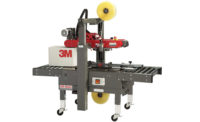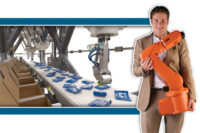Machinery Technology
The latest trends and innovations in multi-packing machinery

Roberts PolyPro uses less plastic in their handles than competitive products and require one-quarter the shipping space due to their unique design.

Bradman Lake’s DRT FT120 Multipack System collates and loads primary wraps into a choice of two secondary packages.

Tripack’s 400 Series models are flexible, mandrel based shrink sleeve applicators with a range of 1 – 10”.



In a world where more is more, where consumers are buying in bulk and club store popularity is on the rise, multipacking has in turn risen in popularity within the packaging industry. Consumers want the convenience of buying multiple of their favorite products at once and at a discount, and companies have been quick to jump on that bundling band wagon to compete and supply, looking for the best of the best in multipacking materials and machinery.
According to a recent study by Research and Markets (researchandmarkets.com), titled, “Stretch and Shrink Films Market in the US 2015-2019,” the stretch and shrink materials market in the U.S. is set to grow at a compound annual growth rate of 3.76% over that five year period.
Also, according to the report, one of the major drivers of the market is the demand for high-quality flexible packaging films, thanks to the rise in appeal of multipacking. Stretch films are widely used to wrap consumer goods and food products, so the high-quality flexible packaging films reduce the cost of production and are environmentally friendly, two big trends in the market today.
The report also states that one of the challenges that the market is facing is increased competition between local and multinational vendors in the market. Vendors who can deliver large shipments make it difficult for new vendors to enter the market.
Machinery upgrades increase flexibility
With multipacking staying constant and on the rise, the stretch and shrink film market adjusts itself accordingly, while the multipacking machinery market is evolving, with many companies rolling out new, innovative and updated machines.
One company taking notice to the rising stretch and shrink film trend is Tripack (tripack.net). The company’s 400 Series models are some of the most flexible, mandrel based shrink sleeve applicators on the market, with a range of 1 – 10” (40 – 400mm layflat width shrink sleeve).
Every twin pack has its unique handling requirements, which is where Tripack engineering excels, according to the company, by designing the right infeed/grouping components that ensure that products are oriented and positioned together for accurate sleeve application. If a packaging company isn’t ready to install its own system, Tripack’s contract packaging division will run its twin packs on one of many automated systems, providing a high quality package using Tripack’s state of the art technology.
Another multipacking innovation rolled out by Omega Design Corporation (OmegaDesign.com), is the new Quantum Class Band-It Stretch Bander, an inline stretch bander capable of handling a wide range of cartons.
The Band-It, part of Omega’s new Quantum Class of premium packaging equipment, has the ability to process up to 300 cartons per minute and is easily integrated into new and existing packaging lines. It offers a compact footprint and balcony-style design and allows for easy user access, product visibility and modular add-ons.
This new innovation has integrated vertical carton stacking capabilities through state-of-the-art components and 5-7 servo motors for optimum motion control. It features advanced recipe control and quick changeover protocol, and comes standard with Allen-Bradley 1000 Panel View on a swing arm. Fully safety guarded throughout, the Band-It can be utilized to complement Omega Design Corp.’s line of serialization solutions and can be configured for the bundling of bottles.
Bradman Lake’s (bradmanlake.com) Dual Race Track (DRT) FT120 Multipack System is a Robotic Toploader that automatically collates and loads primary wraps into a choice of two secondary packages, either a film multipack or a rigid chipboard retail carton. The robotic DRT Toploader incorporates both the FT120 multipack flow wrapper and a carton management system with the option to switch to either method of loading.
As a multi-functional machine capable of top loading products directly into multiples of cartons and trays, or collating and transferring product into infeed conveyor of a FT120 multi-pack flow wrapper, the machine employs state of the art technology in all functions. The DRT comprises of two pairs of servo driven transmission belts with one or two trains of product specific pockets attached. Depending upon the infeed position the DRT can produce either ‘flat pack, or ‘on edge’ collations.
It’s still about sustainability
With a large amount of material needed to accomplish multipacking, another big trend suppliers have been picking up on and innovating for is the importance of sustainability.
One of those suppliers, Roberts PolyPro (robertspolypro.com), powered by Pro Mach (promachinc.com), recently featured its line of bottle handles, hooks and hangers and box carriers at PackEx in Toronto, which the company says uses significantly less plastic in its handles than competitive products.
Roberts PolyPro’s unique design and sheet extrusion process manufactures handles that are up to 75% thinner than competitive injection molded products, resulting in a leaner, less wasteful product. The handles require one-quarter the shipping space of competitive products due to their unique design. This means more handles per cubic foot of space for greater pallet utilization. According to the company, each truck carries more handles so there are fewer trucks required and consequently lower shipping costs, less diesel or gas consumed, and fewer greenhouse gas emissions from transportation.
When used in conjunction with most rigid plastic containers, Roberts PolyPro says their plastic products help brand owners maintain a truly recyclable end product. The handles are ideal for PET and HDPE bottles in industries like bottled water, carbonated soft drinks, health energy, sports beverages, and more, because the 100% HDPE handles can be recycled in most areas with plastic recycling programs.
Whether it’s packaged with a handle, bundled with stretch and shrink film or together in a carton, consumers are demanding more of multi-packs and suppliers are stepping up to fulfill those needs and wants with new, improved and sustainable innovations.
Looking for a reprint of this article?
From high-res PDFs to custom plaques, order your copy today!










